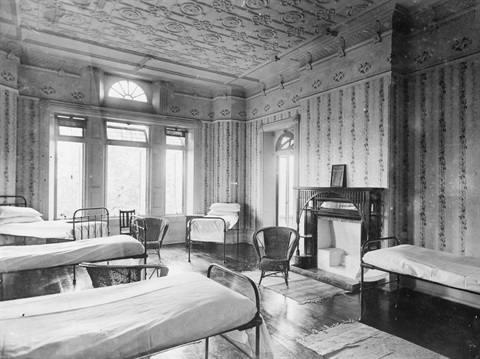Heritage videos

View videos about the history of Bundoora Homestead Art Centre.
Welcome to Bundoora Homestead Art Centre
Built in 1900, Bundoora Homestead is a magnificent Queen Anne-style Federation mansion operating as a historic house, art gallery and café.
Registered by Heritage Victoria and certified by the National Trust, Bundoora Homestead Art Centre is a public art gallery for Darebin, hosting contemporary visual arts and craft exhibitions and a public education program, including artist talks, workshops and events, as well as the biennial Darebin Art Prize.
Finding sanity talk (March 2021)
Note: Please be aware that this video discusses sensitive content around mental health. Viewer discretion is advised.
Held at Bundoora Homestead Art Centre, "Finding sanity" author Dr Greg de Moore gave an insightful presentation on Dr John Cade.
Dr John Cade was an Australian doctor who discovered the use of lithium as the first pharmacological treatment for mental illness at Bundoora Homestead (formerly Bundoora Repatriation Mental Hospital).
After the presentation, Dr Greg was joined by Dr John Cade's son for a conversation chaired by Sophie Kahl, collections and heritage officer.
This talk accompanied Shannon Lyon's exhibition "Li" at Bundoora Homestead Art Centre, paying homage to the caregiving environment that once existed at this site.
Dr Greg de Moore is co-author of "Finding Sanity: John Cade, lithium and the taming of bipolar disorder".
Alexander "Alec" John Robb, Bundoora Homestead Heritage Film Series
Alexander "Alec" John Robb was a patient at Bundoora Repatriation Hospital periodically for 35 years.
After serving in WWI and surviving the ANZAC landing at Gallipoli, he spent time recovering in a hospital in the South of England. While there he met Marjorie, whom he married in 1918.
After returning to Australia, Alec was hospitalised dozens of times before making a strong and rapid recovery in 1954. His daughter Marjorie has suggested that her father may have been successfully treated with lithium under the care of Dr John Cade. After 1954 Alec was able to live with his family in the community and never returned to the hospital.
Dr John Cade, Bundoora Homestead Heritage Film Series
Dr John Cade AO began his tenure at Bundoora Repatriation Mental Hospital in 1939 as a medical officer. He enlisted in the Australian Imperial Force (AIF) in July 1940 and was assigned to the 2/9 Field Ambulance. When Singapore fell to the Japanese in 1942, Dr Cade, along with thousands of other Allied troops, became a prisoner of war at Changi camp until the end of the war.
On his return to Australia, Dr Cade resumed his position at Bundoora and in 1947 was promoted to senior medical officer. He strongly believed that some mental illnesses were caused by metabolic disturbance and set about testing his theory in a disused kitchen of an old ward that served as his research laboratory.
The results of Dr Cade's subsequent discovery of the calming effects produced by lithium carbonate in treating mental illness were presented in a paper entitled, Lithium salts in the treatment of psychotic excitement, published in the Medical Journal of Australia (1949).
Wilfred Collinson, Bundoora Homestead Heritage Film Series
Wilfred Collinson served in WWI after enlisting in 1914 when he was just 19 years old.
After the war, he returned to Melbourne and married Carline Aminde.
Neither Wilfred or Carline could foresee that the trauma from his war experience would lead Wilfred to Bundoora Repatriation Hospital, where he would live for 35 years until his death in 1972.
Henry "Lofty" Cannon, Bundoora Homestead Heritage Film Series
Henry Judge Cannon ("Lofty" to his mates and "Harry" to his family) served in WWII and was in the same unit as Dr. John Cade, the 2/9 Field Ambulance.
Lofty spent time as a prisoner of war working on the infamous Thai-Burma Railway where, as a medic, he treated the famous British satirical cartoonist Ronald Searle. Upon returning home, Lofty’s mental health took a turn for the worse and he spent many years at Bundoora Repatriation Hospital until his death in 1980.
Lofty was involved in setting up the patient magazine "Outlook" and establishing the book exchange program.
Patrick "Paddy" Campbell, Bundoora Homestead Heritage Film Series
Patrick Joseph Xavier Campbell identified so strongly with his nicknames 'Irish' or 'Paddy' that he celebrated his birthday on St Patrick's Day, rather than his actual birthday.
Patrick signed up on 7 June 1940 and was assigned to the medical corps before becoming a prisoner-of-war at Changi camp.
After returning home in 1945 Patrick's mental health suffered and he was admitted to the Heidelberg Repatriation Hospital. A short time later he was transferred to Bundoora Repatriation Hospital at the request of his family.
Image: Upstairs Ward, Bundoora Convalescent Farm c.1929. Courtesy Australian War Memorial